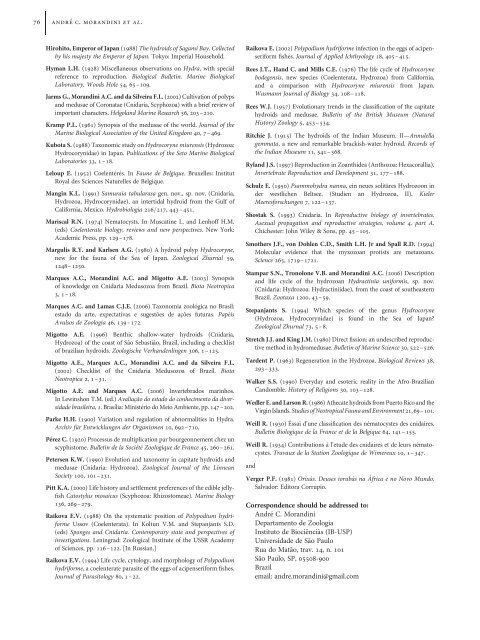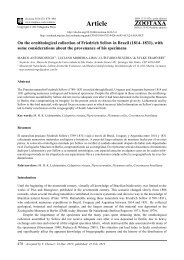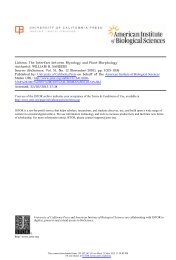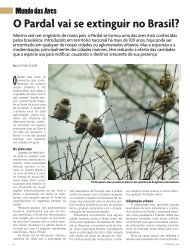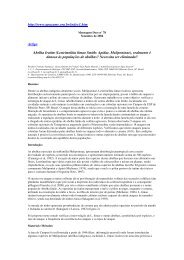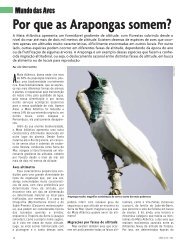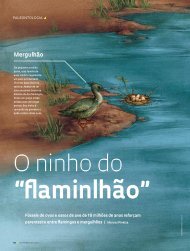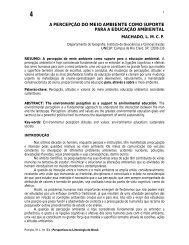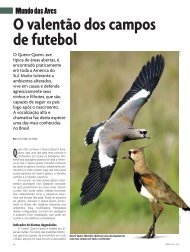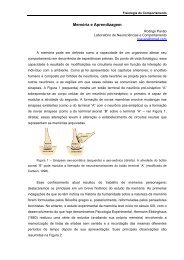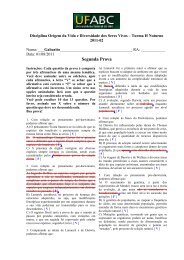Hydrocoryne iemanja (Cnidaria) - Instituto de Biociências - USP
Hydrocoryne iemanja (Cnidaria) - Instituto de Biociências - USP
Hydrocoryne iemanja (Cnidaria) - Instituto de Biociências - USP
Create successful ePaper yourself
Turn your PDF publications into a flip-book with our unique Google optimized e-Paper software.
76 andre c.morandiniet al.<br />
Hirohito, Emperor of Japan (1988) The hydroids of Sagami Bay. Collected<br />
by his majesty the Emperor of Japan. Tokyo: Imperial Household.<br />
Hyman L.H. (1928) Miscellaneous observations on Hydra, with special<br />
reference to reproduction. Biological Bulletin. Marine Biological<br />
Laboratory, Woods Hole 54, 65–109.<br />
Jarms G., Morandini A.C. and da Silveira F.L. (2002) Cultivation of polyps<br />
and medusae of Coronatae (<strong>Cnidaria</strong>, Scyphozoa) with a brief review of<br />
important characters. Helgoland Marine Research 56, 203–210.<br />
Kramp P.L. (1961) Synopsis of the medusae of the world. Journal of the<br />
Marine Biological Association of the United Kingdom 40, 7–469.<br />
Kubota S. (1988) Taxonomic study on <strong>Hydrocoryne</strong> miurensis (Hydrozoa:<br />
Hydrocorynidae) in Japan. Publications of the Seto Marine Biological<br />
Laboratories 33, 1–18.<br />
Leloup E. (1952) Coelentérés. In Faune <strong>de</strong> Belgique. Bruxelles: Institut<br />
Royal <strong>de</strong>s Sciences Naturelles <strong>de</strong> Belgique.<br />
Mangin K.L. (1991) Samuraia tabularasa gen. nov., sp. nov. (<strong>Cnidaria</strong>,<br />
Hydrozoa, Hydrocorynidae), an intertidal hydroid from the Gulf of<br />
California, Mexico. Hydrobiologia 216/217, 443–451.<br />
Mariscal R.N. (1974) Nematocysts. In Muscatine L. and Lenhoff H.M.<br />
(eds) Coelenterate biology, reviews and new perspectives. New York:<br />
Aca<strong>de</strong>mic Press, pp. 129–178.<br />
Margulis R.Y. and Karlsen A.G. (1980) A hydroid polyp <strong>Hydrocoryne</strong>,<br />
new for the fauna of the Sea of Japan. Zoological Zhurnal 59,<br />
1248–1250.<br />
Marques A.C., Morandini A.C. and Migotto A.E. (2003) Synopsis<br />
of knowledge on <strong>Cnidaria</strong> Medusozoa from Brazil. Biota Neotropica<br />
3, 1–18.<br />
Marques A.C. and Lamas C.J.E. (2006) Taxonomia zoológica no Brasil:<br />
estado da arte, expectativas e sugestões <strong>de</strong> ações futuras. Papéis<br />
Avulsos <strong>de</strong> Zoologia 46, 139–172.<br />
Migotto A.E. (1996) Benthic shallow-water hydroids (<strong>Cnidaria</strong>,<br />
Hydrozoa) of the coast of São Sebastião, Brazil, including a checklist<br />
of brazilian hydroids. Zoologische Verhan<strong>de</strong>nlingen 306, 1–125.<br />
Migotto A.E., Marques A.C., Morandini A.C. and da Silveira F.L.<br />
(2002) Checklist of the <strong>Cnidaria</strong> Medusozoa of Brazil. Biota<br />
Neotropica 2, 1–31.<br />
Migotto A.E. and Marques A.C. (2006) Invertebrados marinhos.<br />
In Lewinshon T.M. (ed.) Avaliaçãodoestadodoconhecimentodadiversida<strong>de</strong><br />
brasileira, 1. Brasília: Ministério do Meio Ambiente, pp. 147–202.<br />
Parke H.H. (1900) Variation and regulation of abnormalities in Hydra.<br />
Archiv für Entwicklungen <strong>de</strong>r Organismen 10, 692–710.<br />
Pérez C. (1920) Processus <strong>de</strong> multiplication par bourgeonnement chez un<br />
scyphistome. Bulletin <strong>de</strong> la Société Zoologique <strong>de</strong> France 45, 260–261.<br />
Petersen K.W. (1990) Evolution and taxonomy in capitate hydroids and<br />
medusae (<strong>Cnidaria</strong>: Hydrozoa). Zoological Journal of the Linnean<br />
Society 100, 101–231.<br />
Pitt K.A. (2000) Life history and settlement preferences of the edible jellyfish<br />
Catostylus mosaicus (Scyphozoa: Rhizostomeae). Marine Biology<br />
136, 269–279.<br />
Raikova E.V. (1988) On the systematic position of Polypodium hydriforme<br />
Ussov (Coelenterata). In Koltun V.M. and Stepanjants S.D.<br />
(eds) Sponges and <strong>Cnidaria</strong>. Contemporary state and perspectives of<br />
investigations. Leningrad: Zoological Institute of the USSR Aca<strong>de</strong>my<br />
of Sciences, pp. 116–122. [In Russian.]<br />
Raikova E.V. (1994) Life cycle, cytology, and morphology of Polypodium<br />
hydriforme, a coelenterate parasite of the eggs of acipenseriform fishes.<br />
Journal of Parasitology 80, 1–22.<br />
Raikova E. (2002) Polypodium hydriforme infection in the eggs of acipenseriform<br />
fishes. Journal of Applied Ichthyology 18, 405–415.<br />
Rees J.T., Hand C. and Mills C.E. (1976) The life cycle of <strong>Hydrocoryne</strong><br />
bo<strong>de</strong>gensis, new species (Coelenterata, Hydrozoa) from California,<br />
and a comparison with <strong>Hydrocoryne</strong> miurensis from Japan.<br />
Wasmann Journal of Biology 34, 108–118.<br />
Rees W.J. (1957) Evolutionary trends in the classification of the capitate<br />
hydroids and medusae. Bulletin of the British Museum (Natural<br />
History) Zoology 5, 453–534.<br />
Ritchie J. (1915) The hydroids of the Indian Museum. II—Annulella<br />
gemmata, a new and remarkable brackish-water hydroid. Records of<br />
the Indian Museum 11, 541–568.<br />
Ryland J.S. (1997) Reproduction in Zoanthi<strong>de</strong>a (Anthozoa: Hexacorallia).<br />
Invertebrate Reproduction and Development 31, 177–188.<br />
Schulz E. (1950) Psammohydra nanna, ein neues solitäres Hydrozoon in<br />
<strong>de</strong>r westlichen Beltsee. (Studien an Hydrozoa, II). Kieler<br />
Meeresforschungen 7, 122–137.<br />
Shostak S. (1993) <strong>Cnidaria</strong>. In Reproductive biology of invertebrates.<br />
Asexual propagation and reproductive strategies, volume 4, part A.<br />
Chichester: John Wiley & Sons, pp. 45–105.<br />
Smothers J.F., von Dohlen C.D., Smith L.H. Jr and Spall R.D. (1994)<br />
Molecular evi<strong>de</strong>nce that the myxozoan protists are metazoans.<br />
Science 265, 1719–1721.<br />
Stampar S.N., Tronolone V.B. and Morandini A.C. (2006) Description<br />
and life cycle of the hydrozoan Hydractinia uniformis, sp. nov.<br />
(<strong>Cnidaria</strong>: Hydrozoa: Hydractiniidae), from the coast of southeastern<br />
Brazil. Zootaxa 1200, 43–59.<br />
Stepanjants S. (1994) Which species of the genus <strong>Hydrocoryne</strong><br />
(Hydrozoa, Hydrocorynidae) is found in the Sea of Japan?<br />
Zoological Zhurnal 73, 5–8.<br />
Stretch J.J. and King J.M. (1980) Direct fission: an un<strong>de</strong>scribed reproductive<br />
method in hydromedusae. Bulletin of Marine Science 30, 522–526.<br />
Tar<strong>de</strong>nt P. (1963) Regeneration in the Hydrozoa. Biological Reviews 38,<br />
293–333.<br />
Walker S.S. (1990) Everyday and esoteric reality in the Afro-Brazilian<br />
Candomble. History of Religions 30, 103–128.<br />
Wedler E. and Larson R. (1986) Athecate hydroids from Puerto Rico and the<br />
Virgin Islands. Studies of Neotropical Fauna and Environment 21, 69–101.<br />
Weill R. (1930) Éssai d’une classification <strong>de</strong>s nématocystes <strong>de</strong>s cnidaires.<br />
Bulletin Biologique <strong>de</strong> la France et <strong>de</strong> la Belgique 64, 141–155.<br />
Weill R. (1934) Contributions à l’etu<strong>de</strong> <strong>de</strong>s cnidaires et <strong>de</strong> leurs nématocystes.<br />
Travaux <strong>de</strong> la Station Zoologique <strong>de</strong> Wimereux 10, 1–347.<br />
and<br />
Verger P.F. (1981) Orixás. Deuses iorubás naÁfrica e no Novo Mundo.<br />
Salvador: Editora Corrupio.<br />
Correspon<strong>de</strong>nce should be addressed to:<br />
André C. Morandini<br />
Departamento <strong>de</strong> Zoologia<br />
<strong>Instituto</strong> <strong>de</strong> Biociênciàs (IB-<strong>USP</strong>)<br />
Universida<strong>de</strong> <strong>de</strong> São Paulo<br />
Rua do Matão, trav. 14, n. 101<br />
São Paulo, SP, 05508-900<br />
Brazil<br />
email: andre.morandini@gmail.com


